📞+86 153 7530 2641 📧 hongjing.Wang@feichuncables.com
AS/NZS 5000.1 and AS/NZS 5000.2 Standards and Their Use in Port Cable Applications
AS/NZS 5000.1 and AS/NZS 5000.2 are essential Australian and New Zealand electrical cable standards for polymer insulated cables in port environments. Learn about voltage specifications, construction requirements, and proper selection for control circuits, power distribution, and lighting systems in challenging maritime conditions.
hongjing.Wang@Feichun
7/9/20257 min read
Introduction
AS/NZS 5000.1 and AS/NZS 5000.2 are electrical cable standards developed by Australia and New Zealand for polymer insulated cables of different voltage levels. These standards play a crucial role in ensuring the safety, reliability, and performance of cables, particularly in applications within challenging environments such as ports. Port environments often involve high temperatures, humidity, and mechanical stress, making the selection of cables that meet these standards essential for ensuring stable operation of electrical systems.
The marine environment presents unique challenges that demand robust electrical infrastructure. Salt spray corrosion, temperature fluctuations, continuous vibration from heavy machinery, and exposure to harsh weather conditions all contribute to an environment that tests the limits of electrical components. Port facilities must maintain 24-hour operations, handling millions of tonnes of cargo annually, which means electrical failures can result in significant operational disruptions and economic losses.
This article explores in detail the definitions of these two standards, cable structures, and their specific applications in port cable installations. Understanding these standards enables engineers, facility managers, and electrical contractors to make informed decisions when specifying cables for port infrastructure projects.


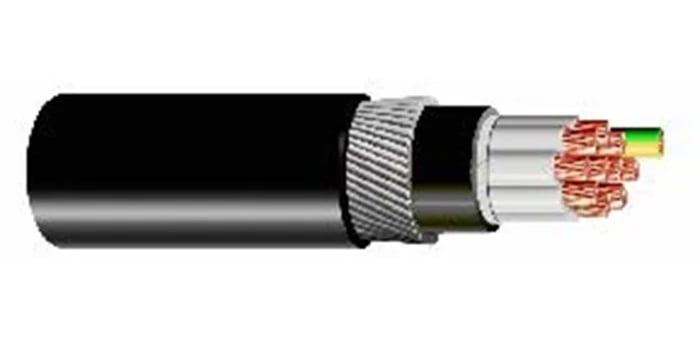

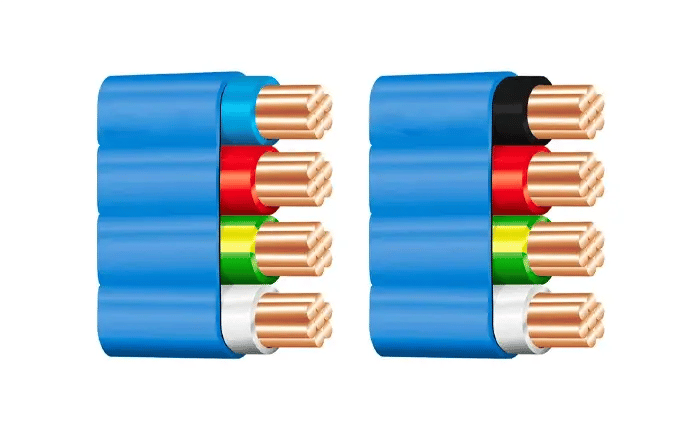

AS/NZS 5000.1 Standard
Definition and Scope
AS/NZS 5000.1 standard applies to polymer insulated cables with working voltages up to 0.6/1 kV, primarily used in control circuits. The standard specifies the construction, materials, testing, and performance requirements of cables to ensure their safe operation in various installation conditions, including unenclosed areas, cable ducts, direct burial, or underground pipelines.
This standard was developed to address the specific needs of medium-voltage applications where reliable signal transmission and control functions are paramount. The 0.6/1 kV rating provides adequate safety margins for control applications while ensuring compatibility with standard industrial control systems commonly found in port facilities.
The scope encompasses both single-core and multi-core cable configurations, allowing flexibility in system design. The standard addresses installation methods ranging from aerial mounting to underground burial, acknowledging the diverse installation requirements found in port environments.
Cable Construction and Materials
According to the standard, AS/NZS 5000.1 cables generally have the following construction:
Conductor: Annealed copper conductor in accordance with AS/NZS 1125. The use of annealed copper ensures optimal conductivity and flexibility, essential for installations subject to vibration and movement. The conductor construction follows stranded designs that provide superior flexibility compared to solid conductors while maintaining excellent current-carrying capacity.
Insulation: V-90 polyvinyl chloride (PVC) insulation material is used, which demonstrates excellent high-temperature resistance. This insulation type can withstand continuous operation at elevated temperatures while maintaining electrical integrity. The V-90 designation indicates compliance with specific temperature and performance criteria essential for reliable operation in port environments.
Sheath and Armour: May include steel wire armour (SWA) and 5V-90 PVC outer sheath for additional mechanical protection. The steel wire armour provides exceptional resistance to mechanical damage, crushing forces, and rodent attack. This protection is particularly valuable in port installations where cables may be subject to impact from cargo handling equipment or construction activities.
Temperature Range: Maximum continuous operating temperature is 75°C, with capability up to 90°C without mechanical deformation in accordance with AS/NZS 3008.1. This temperature range accommodates the elevated ambient temperatures common in port facilities, particularly in equipment rooms and areas with limited ventilation.
Applications in Port Environments
In port environments, AS/NZS 5000.1 cables can be used in the following scenarios:
Control Circuits: For signal transmission and control of port equipment such as cranes, conveyor belts, and lighting control systems. These applications require reliable signal integrity and immunity to electromagnetic interference from adjacent high-power systems. The cable construction provides adequate shielding and insulation to maintain signal quality in electrically noisy environments.
Buried or Ducted Installation: Suitable for underground power distribution or control lines in port areas, protecting the cable from moisture and mechanical damage. The robust construction withstands ground movement, water ingress, and chemical exposure from soil conditions. Direct burial applications benefit from the enhanced mechanical protection provided by steel wire armour.
High Temperature Environment: The high-temperature resistance of the cable makes it suitable for high-temperature areas in ports caused by equipment operation or climatic conditions. This capability is particularly important in tropical ports where ambient temperatures remain elevated year-round, and in equipment installations where heat generation is significant.
AS/NZS 5000.2 Standard
Definition and Scope
The AS/NZS 5000.2 standard applies to single-core and multi-core polymer insulated cables with working voltages up to 450/750 V, designed for fixed power and lighting circuits. The standard specifies the construction, dimensions, and testing requirements of cables suitable for fixed installations such as laying in air, in cable ducts, underground cable ducts, or direct burial.
This standard addresses the substantial low-voltage electrical requirements found in port facilities, from general power distribution to specialised lighting systems. The 450/750 V rating provides adequate capacity for most fixed installation requirements while maintaining cost-effectiveness for large-scale installations.
The standard encompasses comprehensive testing requirements that ensure cables perform reliably under the specific conditions encountered in port environments. These tests include electrical performance verification, mechanical strength testing, and environmental resistance evaluation.
Cable Construction and Materials
Typical constructions of AS/NZS 5000.2 cables include:
Conductor: Annealed copper conductor in accordance with AS/NZS 1125. The conductor design emphasises reliability and current-carrying capacity appropriate for power and lighting applications. Stranded construction provides flexibility for installation while maintaining excellent electrical performance.
Insulation: PVC or other polymer insulation material, resistant to high temperatures up to 90°C. The insulation system provides reliable electrical separation while resisting environmental degradation from moisture, chemicals, and temperature cycling. Advanced polymer formulations offer improved performance compared to traditional insulation materials.
Sheath: Non-metallic sheath providing environmental and mechanical protection. The sheath design balances protection requirements with installation flexibility, offering resistance to moisture ingress, chemical exposure, and moderate mechanical stress.
Number of Cores: Supports single core to four cores plus earth core, with conductor sizes up to 16 mm² (some configurations can reach 25 mm²). This flexibility enables optimised cable selection for specific applications, reducing installation complexity and improving cost-effectiveness.
Application in Port Environments
In port environments, AS/NZS 5000.2 cables are suitable for:
Fixed Power and Lighting Circuits: Provide low-voltage power for power supply and lighting systems in port facilities such as docks, warehouses, and administrative buildings. These installations require reliable power distribution with minimal maintenance requirements. The cable construction ensures long-term reliability under continuous operation.
Multiple Installation Methods: Can be laid in air, in cable ducts, underground pipelines, or directly buried to meet diverse installation needs of ports. This flexibility accommodates the complex infrastructure requirements of port facilities, where installation methods must adapt to existing structures and operational constraints.
Industrial and Commercial Applications: Provide reliable power support in industrial equipment and commercial facilities within ports. These applications include office buildings, maintenance facilities, security systems, and support infrastructure essential for port operations.
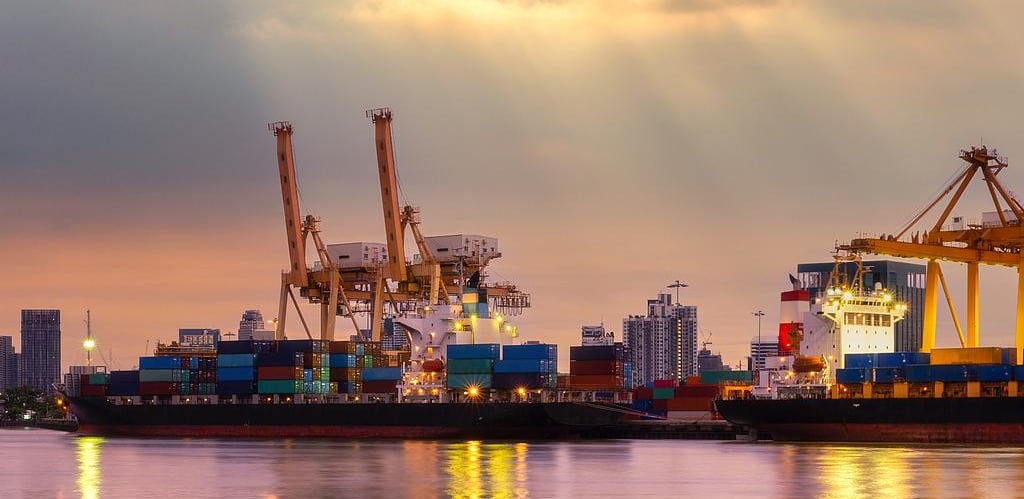

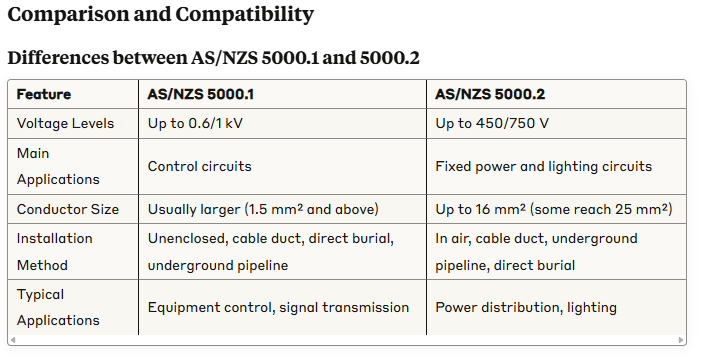

Choice in Port Applications
AS/NZS 5000.1: Suitable for scenarios requiring control and signal transmission, such as automated control systems for port equipment. These applications demand reliable signal integrity and immunity to electrical interference. The higher voltage rating provides adequate safety margins for control system applications while ensuring compatibility with industrial control equipment.
AS/NZS 5000.2: Suitable for fixed power and lighting needs, such as power distribution and lighting facilities in port terminals. These applications prioritise reliable power delivery with cost-effective installation and maintenance characteristics. The lower voltage rating aligns with standard building electrical systems while providing adequate capacity for most fixed installations.
When selecting cables, it is necessary to consider the specific environmental conditions of the port, including salt spray, moisture, mechanical stress, and engineering requirements to ensure that cables meet the standards and pass appropriate tests.
Frequently Asked Questions
Q: What is the primary difference between AS/NZS 5000.1 and AS/NZS 5000.2 cables?
A: The main difference lies in voltage rating and application focus. AS/NZS 5000.1 handles up to 0.6/1 kV and is designed for control circuits, while AS/NZS 5000.2 covers 450/750 V and is intended for fixed power and lighting circuits.
Q: Can these cables withstand the harsh marine environment found in ports?
A: Yes, both standards specify construction materials and methods designed to resist salt spray, moisture, and temperature variations common in port environments. Additional protection measures such as steel wire armour may be specified for severe conditions.
Q: What installation methods are permitted for these cable types?
A: Both standards accommodate multiple installation methods including aerial mounting, cable ducts, underground pipelines, and direct burial. The choice depends on specific application requirements and environmental conditions.
Q: How do you determine the appropriate cable size for a particular application?
A: Cable sizing must consider current carrying requirements, voltage drop limitations, ambient temperature, installation method, and grouping factors. Professional electrical design calculations are recommended for complex installations.
Q: Are special termination methods required for these cables?
A: Standard electrical termination methods apply, though proper techniques for polymer insulation and sheath materials must be followed. Armoured cables require additional termination procedures to properly earth the armour.
Q: What testing is required during installation?
A: Installation testing typically includes insulation resistance testing, continuity verification, and polarity checks. Cables should be tested according to relevant Australian standards and manufacturer recommendations.
Q: How do these standards address fire safety requirements?
A: Both standards incorporate fire resistance characteristics including flame retardant properties and low smoke emission requirements. Additional fire safety measures may be required depending on specific installation locations and local regulations.
Conclusion
AS/NZS 5000.1 and AS/NZS 5000.2 standards provide reliable guidance for port cable applications, ensuring the safety and durability of cables in harsh environments. AS/NZS 5000.1 is suitable for control circuits, ideal for equipment control and signal transmission in ports, while AS/NZS 5000.2 is suitable for fixed power and lighting circuits to meet the power distribution needs of ports.
Understanding these standards enables informed decision-making when specifying electrical infrastructure for port facilities. The robust construction requirements, comprehensive testing protocols, and environmental considerations embedded in these standards ensure reliable performance in the demanding conditions encountered in port operations.
Compliance with these standards, combined with specific environmental assessments of ports, ensures the safety and reliability of cable installation. As port facilities continue to evolve with technological advancement and increasing automation, these standards provide the foundation for electrical infrastructure that supports efficient, safe, and sustainable port operations across Australia and New Zealand.
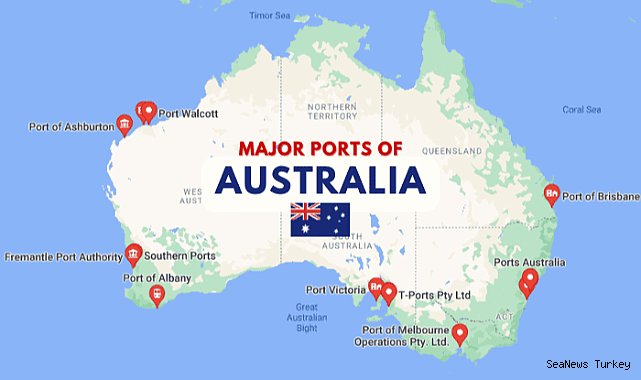

How to Reach Us
Get in Touch
SiteMap
Product Catalogue
Reeling Cable
Festoon Cable
Shore Power Cable




Scan to add us on WeChat
